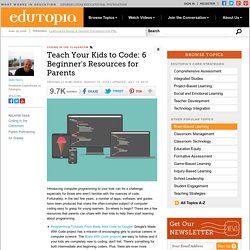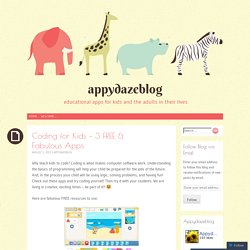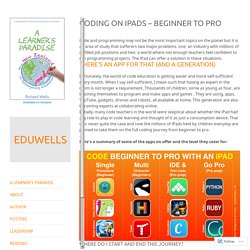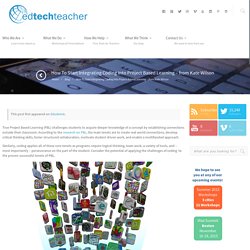

15+ great resources for introducing coding to the classroom. Must-try apps, games, and tutorials for learners of every age“Computer science is a liberal art, it’s something that everyone should be exposed to, everybody should have a mastery of to some extent.”

—Steve Jobs As the world continues to become more and more digital, the number of computer science jobs in this country is rising three times faster than the number of computer science graduates. The problem-solving and logical reasoning skills involved computer programming, as well as the ability to think critically and algorithmically, provide a foundation for virtually every career. It’s no wonder that there has been a surge of interest in having students, particularly those in grades K through 12, learn computer science.
This has led to the development of many new and exciting programs and tools for students. What sets this app apart from all the other tools is that PixelPress integrates the physical world with the digital world. Coding. Kicking off Coding. Teach Your Kids to Code: 6 Beginner's Resources for Parents. Introducing computer programming to your kids can be a challenge, especially for those who aren’t familiar with the nuances of code.

Coding for Kids – 3 FREE & Fabulous Apps. Why teach kids to code?

Coding is what makes computer software work. Understanding the basics of programming will help your child be prepared for the jobs of the future. And, in the process your child will be using logic, solving problems, and having fun! Check out these apps and try coding yourself. Then try it with your students. Coding in the Classroom: 16 Top Resources. As cool as technology is, its intricacies and inner workings are sometimes intimidating, especially for young people who may be more interested in what technology can do for them rather than what they can do with technology.

However, when students hurdle that obstacle and see the value of computer science — specifically coding — they gain a broadened perspective and the potential for a rewarding career in the tech field. The following resources will help you teach your students the basics of coding and will provide tips on how to keep kids interested as you go. Code Club Australia.
Coding - Get EduCreative. Coding in the Classroom: 16 Top Resources. Coding on iPads – Beginner to Pro. Code and programming may not be the most important topics on the planet but it is an area of study that sufferers two major problems. one: an industry with millions of unfilled job positions and two: a world where not enough teachers feel confident to run programming projects.

The iPad can offer a solution in these situations. There’s an app for that (and a generation) Fortunately, the world of code education is getting easier and more self-sufficient every month. When I say self-sufficient, I mean such that having an expert in the room is not longer a requirement. Thousands of children, some as young as four, are teaching themselves to program and make apps and games . Initially, many code teachers in the world were skeptical about whether the iPad had any role to play in code learning and thought of it as just a consumption device. Here’s a summary of some of the apps on offer and the level they cater for: Where do I start and end this journey? Stage one – Single procedure Like this: How To Start Integrating Coding Into Project Based Learning – from Kate Wilson. This post first appeared on Edudemic.

True Project Based Learning (PBL) challenges students to acquire deeper knowledge of a concept by establishing connections outside their classroom. According to the research on PBL, the main tenets are to create real world connections, develop critical thinking skills, foster structured collaboration, motivate student driven work, and enable a multifaceted approach. Similarly, coding applies all of these core tenets as programs require logical thinking, team work, a variety of tools, and – most importantly – perseverance on the part of the student.
Consider the potential of applying the challenges of coding to the proven successful tenets of PBL. Ready to Learn Coding? Here are resources. Plus: Teaching with Scratch. There are several ways to start learning about code, and each offers something a little different.

Not all coding sites are created equal, and not every site or initiative works for every teacher or learner. A playful, introductory experience might not satisfy a teacher looking for a civic-minded coding experience, while an in-depth tutorial on programming games might not be the best starting place for a kid interested in web design. For novices, there are many ways to enter the coding ecosystem. Online coding lessons <Here’s Where to go/> Several sites offer free, online, self-paced lessons to help you learn text-based code—coding in the raw, so to speak.
It’s very common to learn to code by looking at working code and figuring out how and why it works. Although the quality of lessons can be inconsistent, messing around on Codecademy or a similar site is an inexpensive way to learn the basics of programming, and how universal concepts transfer. Starting from Scratch Physical computing.